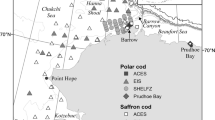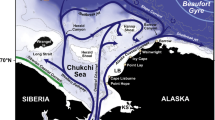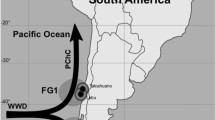Abstract
Climate models indicate the Arctic will undergo dramatic environmental change with forecasted increases in temperature and river runoff. Saffron cod (Eleginus gracilis) is abundant in nearshore waters and appears in the diet of many Arctic sea birds and marine mammals; however, little is known about its early ecology and consequently how they might be affected by environmental changes. We aimed to characterize the mechanisms of spatial and ontogenetic variation in trophic biomarkers (lipid classes, fatty acids and bulk C and N stable isotopes) of saffron cod from the Western Arctic, Chukchi and Bering Seas. Size-standardized analyses showed a significant difference in lipid condition metrics and trophic biomarkers as a function of survey location. Both ontogeny and sampling location played an important role in determining lipid stores with elevated levels in both small offshore juveniles (<55 mm) and larger inshore juveniles (>75 mm). Higher lipid storage in Arctic juveniles was associated with elevated levels of diatom fatty acid markers, but not with nearshore carbon input. Increased lipids were found in age-1 juveniles from Prudhoe Bay in the Western Beaufort that were feeding at a lower trophic level than similarly sized age-0 juveniles from surface trawls in the Bering Sea. The use of otolith annuli revealed two discrete patterns of growth that help explain the trade-offs between energy storage and rapid growth that diverge between the Arctic and Bering Sea. Laboratory temperature-growth experiments confirmed that saffron cod have a eurythermal growth response and are able to store excess lipids at temperatures as high as 20 °C.









Similar content being viewed by others
References
Anderson PJ, Piatt JF (1999) Community reorganization in the Gulf of Alaska following ocean climate regime shift. Mar Ecol-Prog Ser 189:117–123
Anthony JA, Roby DD, Turco KR (2000) Lipid content and energy density of forage fishes from the northern Gulf of Alaska. J Exp Mar Biol Ecol 248:53–78
Bell MV, Dick JR (1991) Molecular-species composition of the major diacyl glycerophospholipids from muscle, liver, retina and brain of cod (Gadus morhua). Lipids 26:565–573
Benoit D, Simard Y, Fortier L (2014) Pre-winter distribution and habitat characteristics of polar cod (Boreogadus saida) in southeastern Beaufort Sea. Polar Biol 37:149–163
Bluhm BA, Gradinger R (2008) Regional variability in food availability for arctic marine mammals. Ecol Appl 18:77–96
Bradbury IR et al (2008) Discrete spatial dynamics in a marine broadcast spawner: re-evaluating scales of connectivity and habitat associations in Atlantic cod (Gadus morhua L.) in coastal Newfoundland. Fish Res 91:299–309
Budge SM, Parrish CC (1998) Lipid biogeochemistry of plankton, settling matter and sediments in Trinity Bay, Newfoundland. II. Fatty acids. Org Geochem 29:1547–1559
Budge SM, Parrish CC (1999) Lipid class and fatty acid composition of Pseudo-nitzschia multiseries and Pseudo-nitzschia pungens and effects of lipolytic enzyme deactivation. Phytochemistry 52:561–566
Budge SM, Iverson SJ, Koopman HN (2006) Studying trophic ecology in marine ecosystems using fatty acids: a primer on analysis and interpretation. Mar Mammal Sci 22:759–801
Budge SM, Wooller MJ, Springer AM, Iverson SJ, McRoy CP, Divoky GJ (2008) Tracing carbon flow in an arctic marine food web using fatty acid-stable isotope analysis. Oecologia 157:117–129
Copeman LA, Parrish CC (2003) Marine lipids in a cold coastal ecosystem: gilbert Bay, Labrador. Mar Biol 143:1213–1227
Copeman LA, Parrish CC, Gregory RS, Wells JS (2008) Decreased lipid storage in juvenile Atlantic cod (Gadus morhua) during settlement in cold-water eelgrass habitat. Mar Biol 154:823–832
Copeman LA, Parrish CC, Gregory RS, Jamieson RE, Wells J, Whiticar MJ (2009) Fatty acid biomarkers in coldwater eelgrass meadows: elevated terrestrial input to the food web of age-0 Atlantic cod Gadus morhua. Mar Ecol-Prog Ser 386:237–251
Copeman LA, Laurel BJ, Parrish CC (2013) Effect of temperature and tissue type on fatty acid signatures of two species of North Pacific juvenile gadids: a laboratory feeding study. J Exp Mar Biol Ecol 448:188–196
Craig PC, Griffiths WB, Haldorson L, McElderry H (1982) Ecological studies of Arctic cod (Boreogadus saida) in Beaufort Sea coastal waters, Alaska. Can J Fish Aquat Sci 39:395–406
Dalsgaard J, St John M (2004) Fatty acid biomarkers: validation of food web and trophic markers using C-13-labelled fatty acids in juvenile sandeel (Ammodytes tobianus). Can J Fish Aquat Sci 61:1671–1680
Dalsgaard J, St John M, Kattner G, Muller-Navarra D, Hagen W (2003) Fatty acid trophic markers in the pelagic marine environment. Adv Mar Biol 46:225–340
Erikstad KE, Reiertsen TK, Barrett RT, Vikebo F, Sandvik H (2013) Seabird-fish interactions: the fall and rise of a common guillemot Uria aalge population. Mar Ecol-Prog Ser 475:267–276
Folch J, Less M, Sloane Stanley GH (1956) A simple method for the isolation and purification of total lipids from animal tissues. J Biol Chem 22:497–509
Fry B, Sherr EB (1983) Use of stable isotopes in marine ecology: a review. Estuaries 6:303
Gradinger RR, Bluhm BA (2004) In-situ observations on the distribution and behavior of amphipods and Arctic cod (Boreogadus saida) under the sea ice of the High Arctic Canada Basin. Polar Biol 27:595–603
Graham C, Oxtoby L, Wang SW, Budge SM, Wooller MJ (2014) Sourcing fatty acids to juvenile polar cod (Boreogadus saida) in the Beaufort Sea using compound-specific stable carbon isotope analyses. Polar Biol 37:697–705
Grant SM, Brown JA (1999) Variation in condition of coastal Newfoundland 0-group Atlantic cod (Gadus morhua): field and laboratory studies using simple condition indices. Mar Biol 133:611–620
Griffiths WB, Fechhelm RG, Gallaway BJ, Martin LR, Wilson WJ (1998) Abundance of selected fish species in relation to temperature and salinity patterns in the Sagavanirktok Delta, Alaska, following construction of the Endicott Causeway. Arctic 51:94–104
Hall JM, Parrish CC, Thompson RJ (2002) Eicosapentaenoic acid regulates scallop (Placopecten magellanicus) membrane fluidity in response to cold. Biol Bull 202:201–203
Harter BB, Elliott KH, Divoky GJ, Davoren GK (2013) Arctic Cod (Boreogadus saida) as prey: fish length-energetics relationships in the Beaufort Sea and Hudson Bay. Arctic 66:191–196
Heintz RA, Vollenweider JJ (2010) Influence of size on the sources of energy consumed by overwintering walleye pollock (Theragra chalcogramma). J Exp Mar Biol Ecol 393:43–50
Heintz RA, Siddon EC, Farley EV, Napp JM (2013) Correlation between recruitment and fall condition of age-0 pollock (Theragra chalcogramma) from the eastern Bering Sea under varying climate conditions. Deep-Sea Res Part II 94:150–156
Helser T, Coleman J, Anderl D, Kastelle C (in revision) Growth dynamics of Saffron cod (Eleginus gracilis) and Arctic cod (Boreogadus saida) in the Northern Bering and Chukchi Seas Deep-Sea Res Part II
Hipfner JM, Adams PA, Bryant R (2000) Breeding success of Black-legged Kittiwakes, Rissa tridactyla, at a colony in Labrador during a period of low Capelin, Mallotus villosus, availability. Can Field Nat 114:413–416
Hobson KA, Welch HE (1992) Observations of foraging Northern Fulmars (Fulmars glacialis) in the Canadian High Arctic. Arctic 45:150–153
Hop H, Gjosaeter H (2013) Polar cod (Boreogadus saida) and capelin (Mallotus villosus) as key species in marine food webs of the Arctic and the Barents Sea. Mar Biol Res 9:878–894
Hurst TP (2007) Causes and consequences of winter mortality in fishes. J Fish Biol 71:315–345
Jaschinski S, Brepohl DC, Sommer U (2011) Seasonal variation in carbon sources of mesograzers and small predators in an eelgrass community: stable isotope and fatty acid analyses. Mar Ecol-Prog Ser 431:69–82
Jobling M, Johansen SJS, Foshaug H, Burkow IC, Jorgensen EH (1998) Lipid dynamics in anadromous Arctic charr, Salvelinus alpinus (L.): seasonal variations in lipid storage depots and lipid class composition. Fish Physiol Biochem 18:225–240
Johnson SW, Thedinga JF, Neff AD (2009) Invasion by saffron cod Eleginus gracilis into nearshore habitats of Prince William Sound, Alaska, USA. Mar Ecol-Prog Ser 389:203–212
Johnson SW, Thedinga JF, Neff AD, Harris PM, Lindeberg MR, Maselko JM, Rice SD (2010) Fish assemblages in nearshore habitats of Prince William Sound, Alaska. Northwest Sci 84:266–280
Kelly JR, Scheibling RE (2012) Fatty acids as dietary tracers in benthic food webs. Mar Ecol-Prog Ser 446:1–22
Laurel BJ, Gregory RS, Brown JA (2003) Predator distribution and habitat patch area determine predation rates on Age-0 juvenile cod Gadus spp. Mar Ecol-Prog Ser 251:245–254
Laurel J, Stoner AW, Ryer CH, Hurst TP, Abookire AA (2007) Comparative habitat associations in juvenile Pacific cod and other gadids using seines, baited cameras and laboratory techniques. J Exp Mar Biol Ecol 351:42–55
Laurel BJ, Ryer CH, Knoth B, Stoner AW (2009) Temporal and ontogenetic shifts in habitat use of juvenile Pacific cod (Gadus macrocephalus). J Exp Mar Biol Ecol 377:28–35
Laurel BJ, Copeman LA, Parrish CC (2012) Role of temperature on lipid/fatty acid composition in Pacific cod (Gadus macrocephalus) eggs and unfed larvae. Mar Biol 159:2025–2034
Layman CA (2007) What can stable isotope ratios reveal about mangroves as fish habitat? B Mar Sci 80:513–527
Layman CA et al (2012) Applying stable isotopes to examine food-web structure: an overview of analytical tools. Biol Rev 87:545–562
Lee RF, Hagen W, Kattner G (2006) Lipid storage in marine zooplankton. Mar Ecol-Prog Ser 307:273–306
Litz MNC, Brodeur RD, Emmett RL, Heppell SS, Rasmussen RS, O’Higgins L, Morris MS (2010) Effects of variable oceanographic conditions on forage fish lipid content and fatty acid composition in the northern California Current. Mar Ecol-Prog Ser 405:71–85
Litzow MA, Urban JD, Laurel BJ (2008) Increased spatial variance accompanies reorganization of two continental shelf ecosystems. Ecol Appl 18:1331–1337
Loseto LL et al (2008) Linking mercury exposure to habitat and feeding behaviour in Beaufort Sea beluga whales. J Marine Syst 74:1012–1024
Lu YH, Ludsin SA, Fanslow DL, Pothoven SA (2008) Comparison of three microquantity techniques for measuring total lipids in fish. Can J Fish Aquat Sci 65:2233–2241
Marcoux M, McMeans BC, Fisk AT, Ferguson SH (2012) Composition and temporal variation in the diet of beluga whales, derived from stable isotopes. Mar Ecol-Prog Ser 471:283–291
Matley JK, Crawford RE, Dick TA (2012) Summer foraging behaviour of shallow-diving seabirds and distribution of their prey, Arctic cod (Boreogadus saida), in the Canadian Arctic. Polar Res 31. doi:10.3402/polar.v31i0.15894
McMahon KW, Ambrose WG, Johnson BJ, Sun MY, Lopez GR, Clough LM, Carroll ML (2006) Benthic community response to ice algae and phytoplankton in Ny Alesund, Svalbard. Mar Ecol-Prog Ser 310:1–14
Merrick RL, Chumbley MK, Byrd GV (1997) Diet diversity of Steller sea lions (Eumetopias jubatus) and their population decline in Alaska: a potential relationship. Can J Fish Aquat Sci 54:1342–1348
Miller CB, Morgan CA, Prahl FG, Sparrow MA (1998) Storage lipids of the copepod Calanus finmarchicus from Georges Bank and the Gulf of Maine. Limnol Oceanogr 43:488–497
Orth RJ, Heck KL, Vanmontfrans J (1984) Faunal communities in seagrass beds: a review of the influence of plant structure and prey characteristics on predator and prey relationships. Estuaries 7:339–350
Parrish CC (1987) Separation of aquatic lipid classes by chromarod thin-layer chromatography with measurement by Iatroscan flame ionization detection. Can J Fish Aquat Sci 44:722–731
Pethybridge H et al (2014) Temporal and inter-specific variations in forage fish feeding conditions in the NW Mediterranean: lipid content and fatty acid compositional changes. Mar Ecol-Prog Ser 512:39–54
Post JR, Parkinson EA (2001) Energy allocation strategy in young fish: allometry and survival. Ecology 82:1040–1051
Post DM, Layman CA, Arrington DA, Takimoto G, Quattrochi J, Montana CG (2007) Getting to the fat of the matter: models, methods and assumptions for dealing with lipids in stable isotope analyses. Oecologia 152:179–189
Quakenbush LT, Citta JJ, George JC, Small RJ, Heide-Jorgensen MP (2010) Fall and winter movements of Bowhead Whales (Balaena mysticetus) in the Chukchi Sea and within a potential petroleum development area. Arctic 63:289–307
Ramos CS, Parrish CC, Quibuyen TAO, Abrajano TA (2003) Molecular and carbon isotopic variations in lipids in rapidly settling particles during a spring phytoplankton bloom. Org Geochem 34:195–207
Renaud PE, Berge J, Varpe O, Lonne OJ, Nahrgang J, Ottesen C, Hallanger I (2012) Is the poleward expansion by Atlantic cod and haddock threatening native polar cod, Boreogadus saida? Polar Biol 35:401–412
Reuss N, Poulsen LK (2002) Evaluation of fatty acids as biomarkers for a natural plankton community. A field study of a spring bloom and a post-bloom period off West Greenland. Mar Biol 141:423–434
Sargent J, McEvoy L, Estevez A, Bell G, Bell M, Henderson J, Tocher D (1999) Lipid nutrition of marine fish during early development: current status and future directions. Aquaculture 179:217–229
Schmutz JA, Hobson KA (1998) Geographic, temporal, and age-specific variation in diets of Glaucous Gulls in western Alaska. Condor 100:119–130
Siddon EC, Heintz RA, Mueter FJ (2013a) Conceptual model of energy allocation in walleye pollock (Theragra chalcogramma) from age-0 to age-1 in the southeastern Bering Sea. Deep-Sea Res Part II 94:140–149
Siddon EC, Kristiansen T, Mueter FJ, Holsman KK, Heintz RA, Farley EV (2013b) Spatial match-mismatch between juvenile fish and prey provides a mechanism for recruitment variability across contrasting climate conditions in the eastern Bering Sea. PLoS One 8(12):e84526
Simonsen KA, Cowan JH, Boswell KM (2015) Habitat differences in the feeding ecology of red snapper (Lutjanus campechanus, Poey 1860): a comparison between artificial and natural reefs in the northern Gulf of Mexico. Environ Biol Fishes 98:811–824
Sogard SM, Olla BL (2000) Endurance of simulated winter conditions by age-0 walleye pollock: effects of body size, water temperature and energy stores. J Fish Biol 56:1–21
Soreide JE, Hop H, Carroll ML, Falk-Petersen S, Hegseth EN (2007) Seasonal food web structures and sympagic-pelagic coupling in the European Arctic revealed by stable isotopes and a two-source food web model. Prog Oceanogr 73:96–98
St John MA, Lund T (1996) Lipid biomarkers: linking the utilization of frontal plankton biomass to enhanced condition of juvenile North Sea cod. Mar Ecol-Prog Ser 131:75–85
Suryan RM, Irons DB, Kaufman M, Benson J, Jodice PGR, Roby DD, Brown ED (2002) Short-term fluctuations in forage fish availability and the effect on prey selection and brood-rearing in the black-legged kittiwake Rissa tridactyla. Mar Ecol-Prog Ser 236:273–287
Takeuchi T (2014) Progress on larval and juvenile nutrition to improve the quality and health of seawater fish: a review. Fish Sci 80:389–403
Thedinga JF, Johnson SW, Neff AD, Hoffman CA, Maselko JM (2013) Nearshore fish assemblages of the northeastern Chukchi Sea, Alaska. Arctic 66:257–268
Tocher DR, Bendiksen EA, Campbell PJ, Bell JG (2008) The role of phospholipids in nutrition and metabolism of teleost fish. Aquaculture 280:21–34
Van Pelt TI, Piatt JF, Lance BK, Roby DD (1997) Proximate composition and energy density of some North Pacific forage fishes. Comp Biochem Phys A 118:1393–1398
von Biela VR, Zimmerman CE, Cohn BR, Welker JM (2013) Terrestrial and marine trophic pathways support young-of-year growth in a nearshore Arctic fish. Polar Biol 36:137–146
Wang SW, Budge SM, Iken K, Gradinger RR, Springer AM, Wooller MJ (2015) Importance of sympagic production to Bering Sea zooplankton as revealed from fatty acid-carbon stable isotope analyses. Mar Ecol-Prog Ser 518:31–50
Welch HE et al (1992) Energy-flow through the marine ecosystem of the Lancaster Sound region, Arctic Canada. Arctic 45:343–357
Wold A et al (2011) Life strategy and diet of Calanus glacialis during the winter-spring transition in Amundsen Gulf, south-eastern Beaufort Sea. Polar Biol 34:1929–1946
Wong S, Walkusz W, Hanson M, Papst MH (2013) The influence of the Mackenzie River plume on distribution and diversity of marine larval fish assemblages on the Canadian Beaufort Shelf. J Marine Syst 127:36–45
Zeller D, Booth S, Pakhomov E, Swartz W, Pauly D (2011) Arctic fisheries catches in Russia, USA, and Canada: baselines for neglected ecosystems. Polar Biol 34:955–973
Acknowledgments
We would like to thank the field crews of the Arctic EIS survey and the ACES survey for helping with the collections of saffron cod in 2012. Fish in this study were supplied from field collections that were supported by both the Bureau of Ocean Energy Management (BOEM) and Coastal Impact Assistance Programs (CIAP). We would like to thank Dr. Franz Mueter for helpful advice and coordination of the large Arctic EIS project. We would also like to acknowledge Michele Ottmar, Scott Hains, Paul Iseri and Chris Magel for help with saffron cod husbandry. Finally, we would like to thank the North Pacific Research Board for Grant # 1228 that supported our research on juvenile Arctic gadids. This is NPRB publication number 571.
Author information
Authors and Affiliations
Corresponding author
Additional information
This article belongs to the special issue on the “Ecology of Arctic Gadids”, coordinated by Franz Mueter, Jasmine Nahrgang, John Nelson, and Jørgen Berge.
Rights and permissions
About this article
Cite this article
Copeman, L.A., Laurel, B.J., Boswell, K.M. et al. Ontogenetic and spatial variability in trophic biomarkers of juvenile saffron cod (Eleginus gracilis) from the Beaufort, Chukchi and Bering Seas. Polar Biol 39, 1109–1126 (2016). https://doi.org/10.1007/s00300-015-1792-y
Received:
Revised:
Accepted:
Published:
Issue Date:
DOI: https://doi.org/10.1007/s00300-015-1792-y




